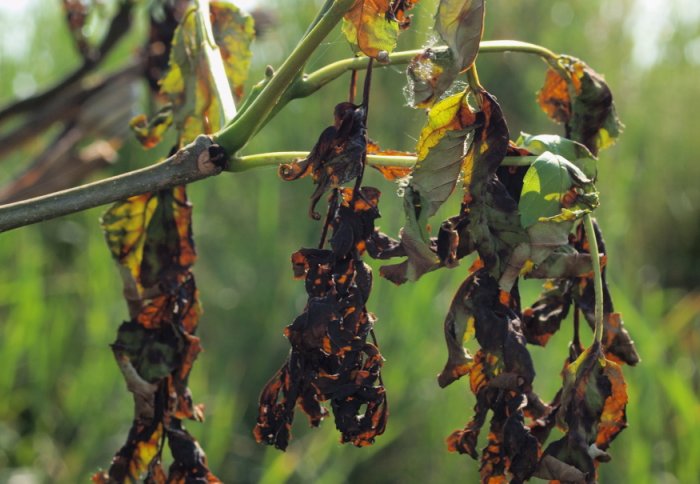Researchers test solution to fungal disease of ash trees
by Simon Levey

Ash affected by Chalara fungus, picture licensed under Creative Commons by HermannFalkner/sokol
Imperial's Silwood Park Campus to carry out field trials for solution it is hoped can control Chalara fungal disease threatening the UK's ash trees
Researchers have developed a low-cost solution that could control the fungal disease that is threatening the UK's 80 million ash trees. Initial tests are being carried out at Imperial College London's Silwood Park Campus in Berkshire, and will continue in Spring 2013.
The fungus Chalara fraxinea entered the country via ash saplings imported from the European mainland and it has led to the destruction of an estimated 100,000 diseased saplings and mature trees in the UK in recent weeks. The UK Government has banned the import of foreign trees and the movement of UK ash trees, but agricultural experts warn this ban is too late because the disease is already established and spreading.
Environmental company Natural Ecology Mitigation is working on the solution with the Forestry Commission's Forest Research unit, the International Pesticide Application Research Consortium (IPARC) and Imperial researchers in the Department of Life Sciences. The consortium is now awaiting the green light from Government and investors to carry out further tests of the product and its mode of use, which would then allow this solution to be rolled out to the nation's woodlands.
Tim Mott, director of Natural Ecology Mitigation, said: "The product is formulated and patented and initial laboratory tests have been successfully completed. We are spearheading the scientific fightback against tree disease and now believe it is necessary to accelerate our laboratory research and field trials in readiness to counter the new threat."
In Denmark, Chalara fraxinea, also known as Ash Dieback, has wiped out 90 per cent of ash trees in just seven years. The disease only recently arrived in the UK, where 80 million ash trees make up over 30 per cent of the deciduous woodland. It has, almost simultaneously, been discovered in Ireland.
The product is called CuPC33 - a solution of copper sulphate and other minerals. Copper has long been used to treat fungal diseases in homes and gardens and a number of copper-based products are safety approved for use by health authorities in the UK. Laboratory trials show that the product is highly effective at controlling fungi that cause tree diseases, and greenhouse trials carried out at the Silwood Park Campus show the product does not harm the trees, either when injected or sprayed onto them.
The scientists say that CuPC33 could be dispersed through infected woodlands by spraying or as a dense medicated mist that lands on leaves and branches. Using technology that atomizes the liquid into very tiny droplets, they anticipate ten litres of diluted CuPC33 is sufficient to treat one hectare of forest at a material cost of less than 60p per litre. The cost of manpower and machines would represent the bulk of the total cost of treatment.
Simon Leather, Visiting Professor in the Department of Life Sciences at Imperial College London, who has been overseeing the field research through Imperial Consultants, said: "We hope to be able to develop a number of ways to apply CuPC33 that will be appropriate to different types of fungal and bacterial diseases and different species of tree. For example, a hand spray formulation of CuPC33 would enable gardeners to treat their ornamental plants and could help to limit the spread of disease.
"The next step for us is to test this solution on infected trees in the field. We expect these trials to begin next Spring."
CuPC33 is effective at killing a number of the fungal pathogens threatening UK trees and plants including Pseudomonas syringae, known as Bleeding Canker of the horse chestnut, and Phytophthora ramorum, which causes Sudden Oak Death, a disease that affects oak and larch trees. CuPC33 is, in the view of the Natural Ecology Mitigation team, going to be equally effective for controlling Chalara fraxinea.
"Mature trees cannot be replaced for generations but, treated in time, infected trees can still be saved for our children and their families. Efforts to combat the spread of the disease by promoting tree health through the use of nutrients have shown few positive results and seem doomed to fail. Quick action is needed now to kill all invading fungal diseases," concluded Mr Mott.
Professor Leather took up a Professorship at Harper Adams University College in Shropshire in October 2012, in addition to his Visiting position at Imperial, and will be part of the Government's new Tree Health and Plant Biosecurity Taskforce. This comprises 10 internationally-recognised experts covering plant and tree health, animal health, risk management, ecology, economics and social science, and was convened in November in light of an increasing number of plant biosecurity threats.
Article text (excluding photos or graphics) © Imperial College London.
Photos and graphics subject to third party copyright used with permission or © Imperial College London.
Reporter
Simon Levey
Communications Division